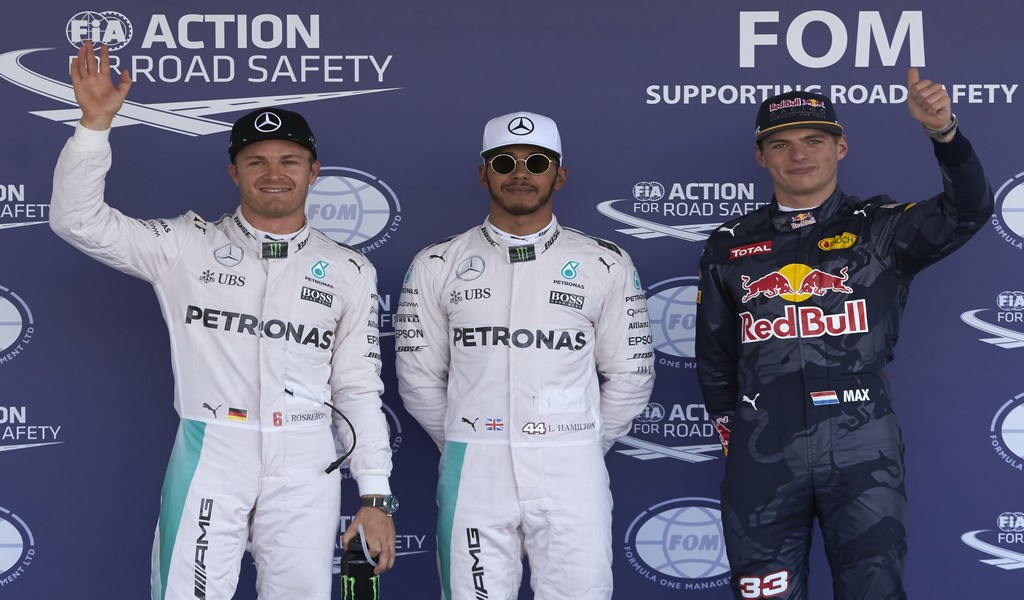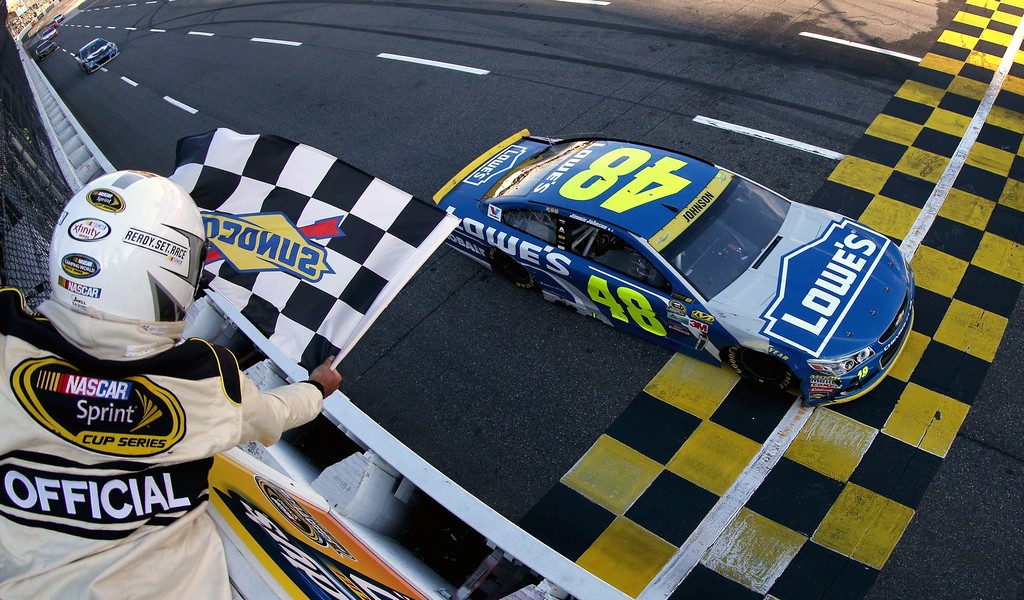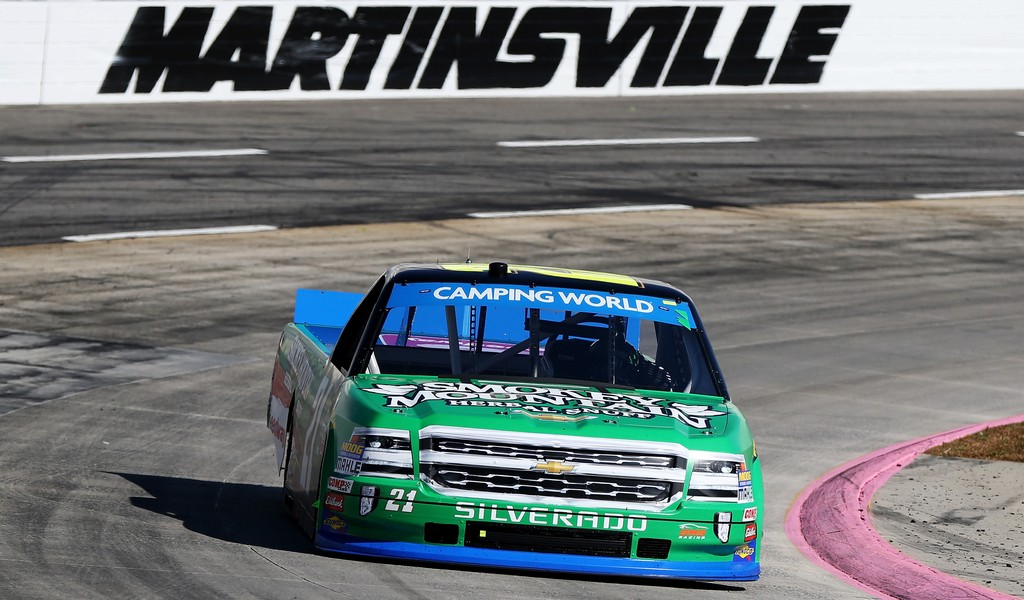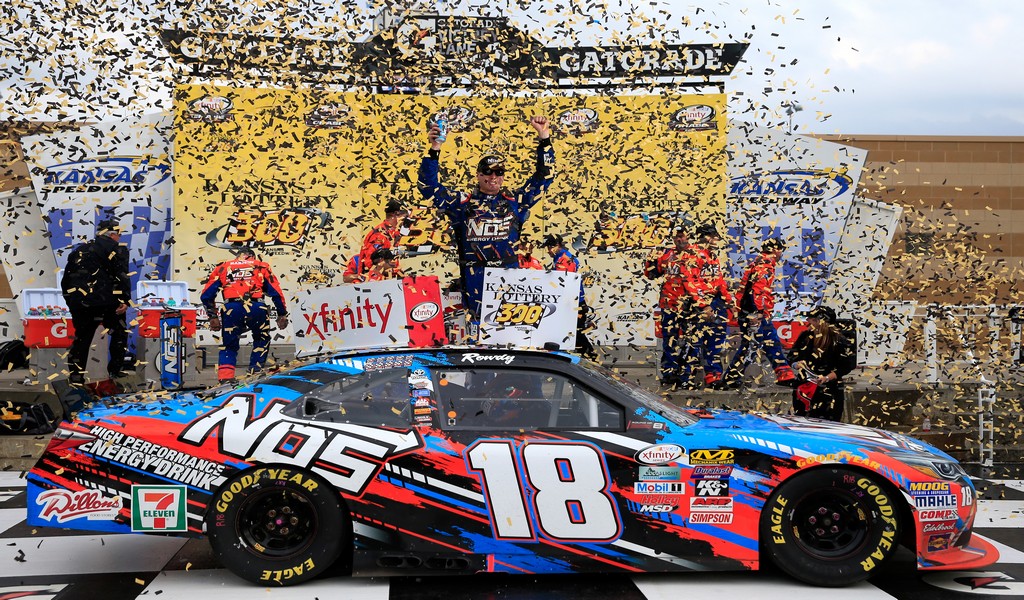
Formula One Gran Premio de México at Autódromo Hermanos Rodríguez in Mexico City
Hamilton and Rosberg finish one-two while the stewards revise positions behind them
Oct. 30, 2016: If you only look at the battle between the two Mercedes drivers, the Mexican Grand Prix was situation as normal. Lewis Hamilton started from the pole alongside his teammate Nico Rosberg and he took the lead into the first corner and – except when he pitted for tires – he led the rest of the way to the checker with Rosberg finishing second, eight seconds behind him. Rosberg still holds the lead in the drivers’ championship by 19 points and he only needs to score a second and a third in the remaining two races to clinch the title.
The results behind these two were more confused. At first Max Verstappen had come to the winners’ room as the third-place finisher but then he was called aside and ushered out of the room. The stewards had determined that a manoeuver he had made when he drove too fast into the first corner and drove across the grass to resume his position in front of Sebastian Vettel’s Ferrari was not proper and they gave him a five second penalty which set him back to fifth behind Vettel and his Red Bull teammate Daniel Ricciardo. Vettel ran up from his pit stall, took the third-place hat from Verstappen and accepted the trophy on the podium
Later, the stewards reviewed a move that Vettel had made on Ricciardo to defend fourth place and deemed it to be “unsafe”. They gave him ten-second penalty which dropped him back to fifth behind Ricciardo and Verstappen.
On the first lap, Hamilton went wide at that first corner and took the same path across the grass that Verstappen took later. A lot of people wondered why Verstappen was penalized when Hamilton was not even though it looked like exactly the same circumstances. Afterwards the stewards explained themselves, saying that they had seen telemetry which showed that Hamilton had backed off immediately to negate the advantage he had gained over Rosberg.
It is never a good thing when the results of a race are determined by race officials rather than by the actions of the race drivers on the track. If we are going to start determining the results on the basis of telemetry information – something the race fan in the grandstand has no hope of seeing – and continuing to hand out post-race penalties which alter the race results in important ways – it will be increasingly difficult to maintain and build a base of real race fans (not counting the poseurs in the Paddock Club).
Kimi Räikkönen brought the second Ferrari home in sixth place, one spot behind his teammate Vettel as it turned out. Nico Hulkenberg was a solid seventh in his Force-India car ahead of Valtteri Bottas in the first of the Williams cars. The Haas team had a terrible result, Esteban Gutiérrez and Romain Grosjean finishing 19th and 20th after starting in 17th and 21st positions.
There are two more races in this year’s Formula One season. The next race is on Nov. 13 at Autodromo Jose Carlos Pace in São Paolo, Brazil.

NASCAR Sprint Cup Goody’s Fast Relief 500 at Martinsville Speedway
Johnson’s win gives him a real shot at his seventh Cup championship
Oct. 30, 2016: There was a time when it seemed as if Jimmie Johnson was going to keep on winning the Cup championship every year. Indeed he won it five years in a row from 2006 to 2010. Then he won it again in 2013, setting off the quest for a seventh championship. Richard Petty and Dale Earnhardt Sr. both won seven titles and Johnson has long looked like being set to be the third to reach this achievement – albeit under a vastly different formula for determining the series champion. Here at Martinsville Johnson emerged as the dominant runner in the closing laps, winning the race and clinching a spot in the championship-determining finale at Homestead.
Brad Keselowski, who had not been a factor for most of the race, came on strong in the final 30 laps and passed everyone and then he started to challenge Johnson for the lead. But his charge came too late and he had to settle for second, 1.3 seconds behind the race winner.
Most of the 500-lap race had been dominated by the Joe Gibbs drivers and Martin Truex, driving the Gibbs-affiliated Furniture Row Toyota. First it was Truex who led for a total of 147 laps. Then Matt Kenseth took over on lap 181 and led the next 175 laps. Denny Hamlin, who had been set back after a penalty for speeding in pit lane, came up through the field and took the lead on lap 356. On his way back up he had been trapped behind Johnson for several laps until he took matters into his own hands and nudged Johnson aside. Unfortunately for Johnson, he suffered damage to his car which forced him to pit twice for repairs during the ensuing caution, dropping him to the back behind many lead lap cars.
After a long, confused final caution which ended on lap 386, Hamlin was in the lead but Johnson was almost immediately challenging him. Over the next few laps these two exchanged the lead several times, running side-by-side for a number of laps. Johnson wisely chose to not retaliate for the damage Hamlin had inflicted earlier and passed him cleanly, taking the lead for good on lap 409. After that, Hamlin faded back a little while Keselowski charged forward to take second place.
Hamlin finished a strong third ahead of his JGR teammates Kenseth and Kyle Busch. The fourth JGR driver, Carl Edwards, finished way back in 36th place after a tire failure caused him to crash heavily into the outside wall – a crash which created confusion and chaos and a long 29-lap caution period while NASCAR tried to sort out the correct running order for the restart.
The confusion was created by an almost unprecedented situation – green-flag pit stops at this short track – and Edwards’ crash came right in the middle of the pit stop sequence when only seven cars were on the lead lap with only another six a lap down. On a short track like this, with all these lead lap, lap-down, two laps-down cars all mixed together and more pit stops occurring under yellow, no one could agree on the correct order in which the cars should line up for the restart.
Finally NASCAR prepared for the restart. There were still cars lined up in the wrong places including some which had made up laps they did not deserve, but it seems as if the front of the field was more-or-less correctly aligned – even if the circumstances of this caution in the midst of the green flag pit stops had been unfair to some top competitors, notably Kenseth. Afterwards, when cooler heads prevailed, many agreed that it would have been wiser for NASCAR to have red-flagged the mess and sorted out the order before they started up the cars again. One beneficiary of this long, long caution was Edwards, whose crew had a long time two work on his severely damaged car before the track went green again - but he still ended up 23 laps down – and his hopes of qualifying for the championship finale at Homestead have to be slim to none now.
During this long period before the pits opened during this final caution, some of the cars that had not pitted under green started to run low on fuel. Johnson’s car slowed on the backstretch and he reported that he was out of fuel. But then he fiddled with some of his switches and apparently activated a reserve of fuel and was able to continue – in fact, he was able to keep circulating until the pits did open and he did not suffer the back-of-the-field penalty he would have earned had he pitted before the pits opened, This would be a major factor in enabling him to start in fourth place; otherwise he would have had little hope of beating the fleet of JGR cars – not to mention the speedy Keselowski – for the win.
This race was probably Jeff Gordon’s final one and his fifth-place finish here was his best as a fill-in for the injured Dale Earnhardt Jr. this year.
This was the first race of the penultimate elimination round, the “round of eight” in which the bottom four of the eight Chase challengers will be eliminated after the Phoenix race. As things stand now, Edwards is in eighth place 32 points behind fourth place Kyle Busch – but given the uncertainty of how this will play out over the next two races and the huge impact one bad finish (such as Edwards’ here) can have, aside from Johnson, any of the other seven may end up in the three remaining spots in the Homestead finale.
Next week the Cup series race is on Nov. 6 at Texas Motor Speedway.

NASCAR Craftsman Truck Series Texas Roadhouse 200 at Martinsville Speedway
Sauter holds off Elliott to clinch his spot in the Chase finale
Oct. 29, 2016: Johnny Sauter’s only previous win this year came at Daytona in February but his win here at Martinsville was a big payoff, clinching a spot in the shootout finale at Homestead. Sauter took the lead for the last time on lap 176 of the 200-lap race, and he held off a hard-charging Chase Elliott to take the win.
John Hunter Nemechek finished third, Christopher Bell was fourth and Timothy Peters fifth. The rookie William Byron, who has looked like the favourite to win the championship, finished in ninth place after a lacklustre race. However, under this Chase format, it only takes one top finish at Homestead to decide the champion.
Elliott is a rookie in the Sprint Cup series this year and he qualified for that series’ Chase. He’s been eliminated by now but he still wants to do as well as he can – and he’s still looking to win the rookie title if not a race win before the season ends. There was a certain logic for the Sprint Cup regular to borrow a truck to run the undercard truck race the day before his Cup race on Sunday – just to learn more about driving this track. But he must have known that his presence was a distraction, if not an annoyance, to the drivers who were trying to stay in contention for the truck championship.
Elliott started from the pole and he was the fastest for most of the race, leading for a total of 109 laps including a 99 lap run through the middle of the race.
On the restart after the third caution on lap 155, John Hunter Nemechek briefly took the lead ahead of Elliott and Sauter but after two more cautions in quick succession, Sauter emerged as the leader ahead of Elliott and Nemechek on lap 176.
The rest of the way after that Elliott stuck to Sauter’s tail. It looked like it would have been so easy for Elliott to give Sauter a nudge and slip under him for the lead but it seemed as if Elliott was conscious of his role here as an interloper in someone else’s party and settled for a controversy-free second. After all, for Elliott, this race was merely a rehearsal for Sunday’s Cup race.
There was controversy though. With less than 25 laps to go, Ben Rhodes “nudged” Ben Kennedy and spun him. This saw Kennedy, who is still one of the Chase contenders, falling a lap down and finishing 18th – and in real danger of elimination from the Chase. Kennedy, who is a scion of the France family, was not happy and confronted Rhodes in the garage area afterwards. Let’s hope that Rhodes doesn’t have too much trouble getting his truck through inspection next week.
Matt Crafton, who was the 2015 series champion, also had trouble. His left rear brake caught fire late in the race. His crew managed a jury-rigged fix and he was able to continue. He finished on the lead lap but in 18th place – a Chase driver in jeopardy of elimination in this round.
There are two more races in this the second-to-last truck Chase elimination round. The next race will be run on Nov. 4 at Texas Motor Speedway.

NASCAR will ban Cup drivers from Chase races in Xfinity and Camping World truck races next year
it had become all too obvious that there was a disconnect between the well-established practice of Cup drivers picking off the low-hanging fruit in the two junior national series – the Xfinity and the trucks – and the new Chase concept as applied to these junior series this year. Just when NASCAR is trying to hype the race for the championship in these series, a Cup driver like Kyle Busch – or Joey Logano – or Brad Keselowski – or Kyle Larson – comes along to divert the fan’s attention from the series’ championship shootout eliminations.
NASCAR needed to decide which they wanted to promote – the Chase-style championship battle amongst the real series contenders or the hopped-up thrill of seeing a Cup driver humble the Xfinity or truck series stalwarts. Clearly, in adding the Chase format to these two junior series, NASCAR had made the decision to turn the spotlight on the series regulars.
So it came as little surprise when last week, NASCAR announced a change in its rules for next year. Cup drivers with five years or more of full-time Cup racing experience will not be eligible to enter any of the Chase rounds in either the Xfinity or the truck series, nor will any Cup driver be allowed to enter any more than ten Xfinity races or seven truck series races during the season. Given that the four-race mid-season “Dash-4-Cash” competition in the Xfinity series is also designed to highlight the junior series regulars as well, five-year Cup veterans will be barred from these races as well.
This has to be a welcome change especially given the bumper crop of up-and-coming new drivers who are relying on success in the junior series to help them make the jump to the Cup series.
However, NASCAR was too conservative in the way they wrote these new rules. They should have applied this to every Cup driver who, at the beginning of the season, opts to collect championship points in the Cup series. This last weekend Chase Elliott, a rookie in the Cup series, entered the truck race at Martinsville to polish his skills for Sunday’s Cup race – and kind of stunk up the show. But for a bit of constraint he could well have won the race – a race that is supposed to have us on the edge of our seats watching the truck series championship contenders battling it out. Why should a rookie Cup driver like Elliott be allowed to race here when NASCAR has recognized that having Cup drivers competing in these championship-deciding races is not a good thing?
Of course, NASCAR and the race promoters want a big crowd for these junior races and the conventional wisdom has seemed to be that the presence of Cup regulars in these races helps fill the seats – not that there have been many bums in seats for these undercard races in recent years anyway. Another worry might be that the loss of the Cup stars may lead to less-than-full fields. But, perhaps without the Cup stars sucking up the sponsorship money, some of that sponsorship money will go to the more deserving junior series regulars and wannabes.
Photo Credits:
F1: Steve Etherington © Daimler AG
NSCS: Matt Sullivan/NASCAR via Getty Images
NCWTS: Matt Sullivan/NASCAR via Getty Images
Busch/Xfinity: Chris Trotman/Getty Images

























